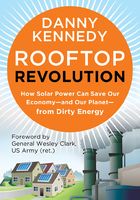
The Grid
The system of wires between these electricity-generating machines and the users of that electricity is known as “the grid.” There are basically two types of wires in the grid. Electricity begins its journey at the types of generators we’ve just discussed (which are usually far from high-population areas). It’s carried on high-voltage transmission wires to “demand centers,” where transformers reduce the electricity’s voltage and send it out via distribution lines to consumers.
Electricity is a vital commodity service that powers our economy. We’re the end users in our homes and offices, and we pay the full retail rate for dirty electricity. A big commercial user—like a factory, a store, or a university—may pay a lower rate, and some industrial users negotiate to buy electricity almost at wholesale prices. This pricing pyramid of lower-cost bulk buying and higher-cost structures for residential and other users has been applied in the United States and many other countries for much of the past century. In China, however, it’s different: to create efficiency in bulk use, China’s utilities charge higher prices, but they ask retail users to pay less because they aim to spread the benefits of electricity to more citizens.
The grid’s complexity has grown over time. The fundamental structure is often described as “hub and spoke”—central-station generators being surrounded by wires out to users—but it’s more like a hub and spaghetti and meatballs, with more and more generators also on the rim and a crisscross of wires around the network.
Managing the grid is challenging. The technology supporting it is one matter, but then consider the interests of the businesses generating the power and maintaining the grid, and then think of the rights of consumers, who are represented by politically appointed regulators of those businesses—and you start to see how the grid is actually a very tangled web!
Nonetheless creating the grid—and thereby providing the service of electricity to a nation of consumers—was one of the great achievements of the twentieth century in the United States. Although nearly 90 percent of urban dwellers had electricity by the 1930s, only 10 percent of rural dwellers did. Private energy companies argued that providing electricity to rural farmers was too expensive (and they charged farmers up to four times more than they charged city dwellers). As part of the New Deal, the Rural Electrification Administration brought the productivity and the personal improvements afforded by electricity to the many farmers who were going without.
Today countries are still judged by their ability to deliver electricity service to more and more people, although a lot of people are still off the grid. At least 1 billion people can’t take electricity for granted; in fact, they’ve probably never experienced it, but they’re likely to in the coming decade as new, more-localized ways of making electricity become commonplace. Their governments—in India and some African countries, for example—are trying to not re-create the brittle twentieth-century model but rather have a more flexible set of resources to serve their communities with electricity. This is actually more reliable and secure; here in the United States, our grid is at risk of breakdown (if a tree falls on a power line, it can trigger the collapse of a whole network as much of the Northeast experienced in 2003) and attack (the grid’s many linkages make it an easy target for terrorists).
One of the resources being deployed in these countries without extensive grids, as they seek to leapfrog the era of dirty-electricity supply built around the expensive and insecure central-station model, is solar power. Places like Germany, India, Japan, and California have also been in the forefront of the Rooftop Revolution as they have connected solar panels to their grids to augment their power supplies; we’ll visit some of these places in later chapters.